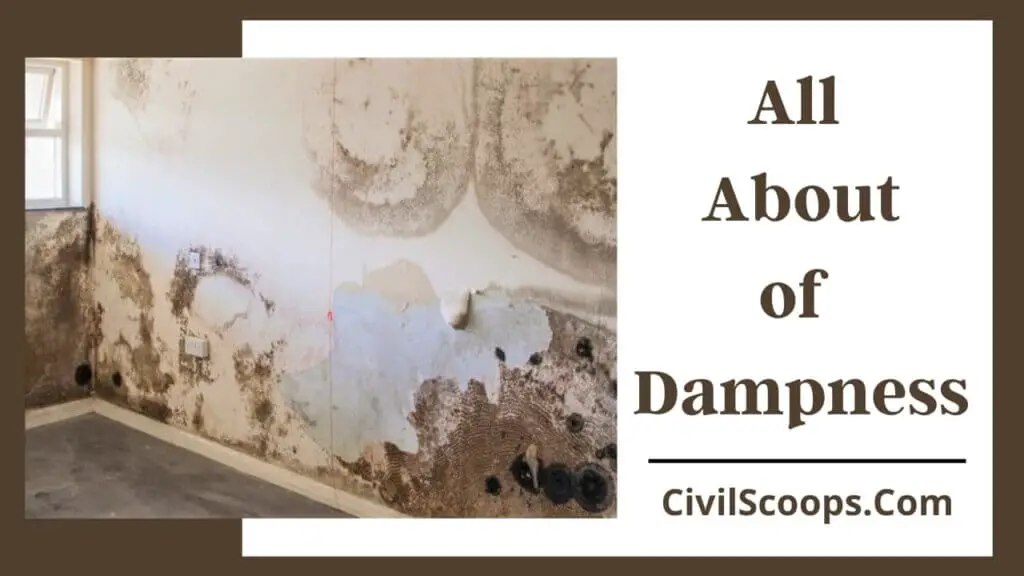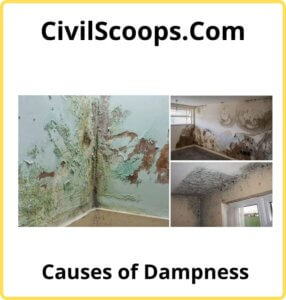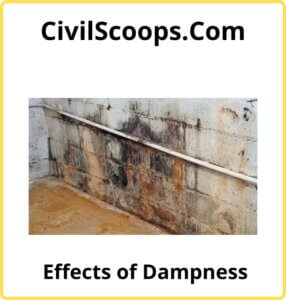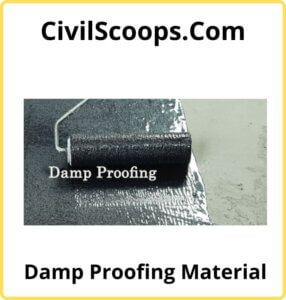What Is Dampness | Causes of Dampness | Effects of Dampness | Damp Proofing Materials | Methods of Damp Proofing

Table of Contents
What Is Dampness ?
Dampness is a property of a building when the water or moisture is absorbed by the building material. Dampness is a very harmful effect, by this a building can also collapse because the load-carrying of the material is getting reduced.
In a damp house, it is very danger for living a person. To overcome this effect civil engineers apply for a course over the plinth level, this course is called Damp Proof Course (DPC). Damp Proof Course is applied when the construction is ongoing.
Causes of Dampness

There are naturally various causes are responsible for the dampness. Those causes are the following-
- Ground Water Table: If the groundwater table is high then it will affect the foundation of the building because the materials which are used in the foundation construction absorbed water from the groundwater table by capillary action. It also happens when the groundwater tale is rise due to heavy rain or other natural effects.
- Rain: The external walls of the building is not protected properly then the rainwater can damage the walls and dampness will occur.
- In some places drainage water is not drained off from the building properly, then it may affect the foundation of the building.
- The dampness can be occurred due to bad materials used and bad workmanship.
- Sometimes in new constructed walls dampness occurred because of a lack of water absorption of water.
- If the roof of the building is too much flat then the rainwater could not pass properly and is stored in the roof, that’s why dampness happens.
- You should need to provide a damp-proof coating on the top surface of the parapet wall. If we don’t do this and dampness may occur then it will create a huge disturbance in our building.
Effects of Dampness

There are many different effects of dampness, those are-
- The main effect of dampness is the plaster becomes soft than the previous one and crumbles in nature.
- The another effect of dampness is the paints and distempers are getting damaged.
- Electric wiring of that building may damaged by the dampness effect.
- Dampness will create an unhealthy condition and atmosphere for the occupants.
- The another major effect of the dampness is the steel reinforcements of the RCC structure is getting corroded, for this the whole load carrying capacity of the building will reduce.
- Dampness will allow various type of insects, fungus and termites.
- It will help the breeding of mosquitoes and their existence.
- The floor material like marble, floor tiles, etc are getting damaged by the dampness.
- Many watery patches are occurred in the walls and ceilings, sometimes plaster becomes bulky in nature.
- By the dampness effect there is always present of moisture content which may cause the efflorescence effect, which is very harmful for any building.
Damp Proofing Material

There are various damp proofing materials are available in the market which are used for the damp proofing, those are-
- Hot Bitumen: Hot bitumen is a flexible material which is used as damp proofing material, it is mainly used on the top surface of concrete or mortar.
- Bituminous Felts: Bituminous felts are also a flexible material which is available in the rollers of the walls width. This material is laid on the cement material and easy to laid down.
- Mastic Asphalt: This is another damp proofing material which is semi-rigid in nature and it creates an impervious layer on the surface.
- Metal Sheets: Metal sheets are mainly made of aluminum or copper which is used as a damp-proof material.
- Stone: Stones are also act as a damp proofing material. Granite, slate, etc which is laid on the cement concrete and resist the dampness effect.
- Cement Concrete: Cement concrete is also a good damp-proof material which is provided in the plinth level, in damp proofing 1:2:4 mix ratio of concrete is used.
- Plastic Sheets: Plastic sheets are generally made with black polythene which is 1mm thickness, it is very effective damp proofing material, easy to use and cheap.
Methods of Damp Proofing

There are various methods and techniques are used for damp proofing, those methods are-
1. Membrane Damp Proofing:
In this method a damp proofing course is applied between the damp part and the building component. Bitumen, mastic asphalt, plastic sheets are mainly used. Damp proofing are mainly provided horizontally but sometimes it can be provided in vertically also.
The general principles are followed-
- Damp proof course must cover the full thickness of the walls.
- The supporting mortar bed of damp proof course must be levelled, even projection free, this is done because of it should not getting damaged.
- In the wall corners or junctions, the damp proof curse must be provided in continuous layer.
- We need to checkout the wall or floor surface otherwise it may affect the finishing work of that particular portion.
2. Integral Damp Proofing:
By this type of damp proofing method, some materials are mixed with the concrete mix and that material creates an impervious layer and it helps to resist the dampness. Generally, one kg of waterproofing material is mixed with one bag of cement.
3. Surface Treatment:
In this technique, we use water repellent materials are used. Wall plasters with a ratio of 1:1:6 are used for preventing dampness.
[su_box title=”FAQ” style=”default” box_color=”#333333″ title_color=”#FFFFFF” radius=”3″ class=”” id=””]
Dampness
Dampness can be thought of as the condition of “high humidity” inside the body. Symptoms can include a feeling of heaviness, swelling or water retention, distended abdomen, phlegm discharge, nodular masses, loose bowels and turbidity of fluids.
Wet Cellar
Meaning: wet basement simply means the accumulation of water caused by a range of issues which include flooding from landscaping or nearby property. The integrity of the house’s foundation will be affected due to the presence of continuous moisture which damages a basement.
Get Rid of Moisture in Basement
- Open the windows. A great way to get air circulating in the room is to open up the windows whenever you’re down there.
- Keep it clean! Storing too many items in your basement will create clutter.
- Seal up any gaps.
- Turn up the heat.
- Get a dehumidifier.
Wet Basement Floor
If you begin to notice wet spots on the basement floors or walls, you probably have a basement moisture problem. Persistent condensation can lead to structural damage. In many cases, a dehumidifier can provide a solution. Another common contributor to a wet basement is runoff from gutters.
Moisture in Basement
There are just three sources of moisture: liquid water from rain or ground water. Interior moisture sources such as humidifiers, unvented clothes dryers, bathrooms and cooking, as well as the moisture in concrete after construction. Exterior humid air enters the basement and condenses on cooler surfaces.
Removing Moisture from Basement
You can air out the basement by opening windows and running fans to circulate the air. You can also try turning up the heat in the basement, as warmer air will prevent moisture from condensing on cool surfaces. Another solution is to use a dehumidifier in your basement.
Wet Crawl Space
So what does it really mean when my crawl space gets damp? The answer is simple. Water or moisture is entering the crawl space. And the source could be anything from high humidity in the air during hot summer months to a leaking water pipe that runs below the crawl space.
Basement Floor Wet Under Carpet
Leaks causing your basement carpet to take on water could be drainage pipes, appliance failure like a water heater going out, or even a sewer system backup. Usually if you find your basement carpet is wet and it is a plumbing issue, you’ll know it right away.
Moisture on Basement Walls
If the outside air is warm and humid, it will condense on the cool basement wall and floor surfaces. Many homeowners see this moisture and believe they are experiencing basement wall leakage, when in fact the accumulated moisture is from condensation.
Wet Carpet in Basement After Rain
Leaks causing your basement carpet to take on water could be drainage pipes, appliance failure like a water heater going out, or even a sewer system backup. Usually if you find your basement carpet is wet and it is a plumbing issue, you’ll know it right away.
[/su_box]
[su_note note_color=”#F2F2F2 ” text_color=”#333333″ radius=”3″ class=”” id=””]
Like this post? Share it with your friends!
Suggested Read –
- What Are Conceptual Sketches | Concept Sketch Definition | Use of Concept Sketches in Class | Using Concept Sketches in the Field | Architecture Concept Drawings | Difference Between Sketches and Drawings
- What Is Ceramic Tiles? | Advantages & Disadvantages of Ceramic Tiles | What Is Vitrified Tiles? | Advantages & Disadvantages Vitrified Tiles | Differences Between Ceramic Tiles and Vitrified Tiles
- What Is Gable Roof | History of Gable Roofing | Gable Roof Design | Parts of Gable Roof | Types of Gable Roofs | How Long Can the Roof Last? | Gable Roof Advantages and Disadvantages | Cost of Gable Roof Construction |
- Building Layout | How to Building Layout | Construction Layout Techniques
- How a Building Is Constructed | Components of Building
[/su_note]
Originally posted 2024-04-05 05:13:59.
